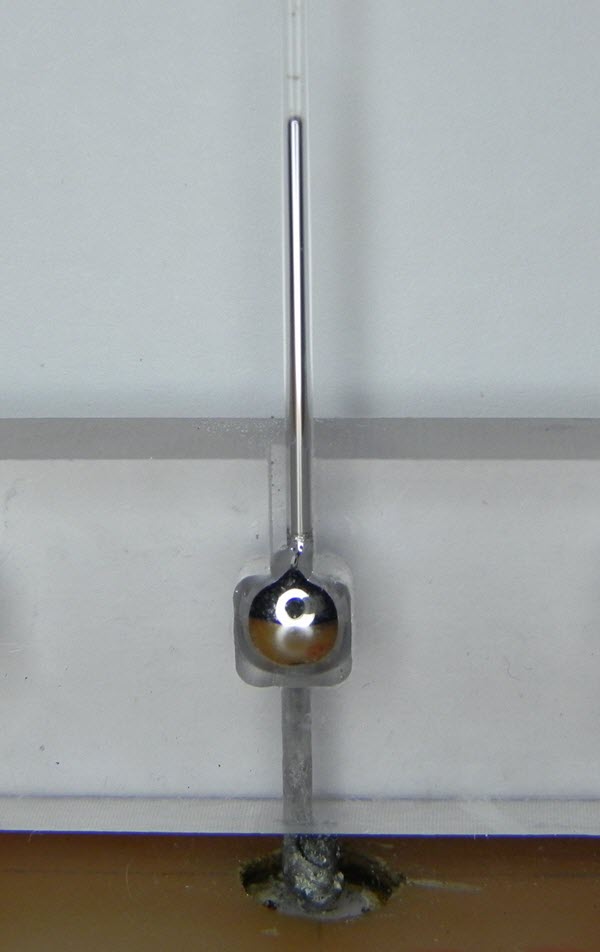Tunable liquid-metal antennas
May 21, 2015
Using electrochemistry, North Carolina State University (NCSU) researchers have created a reconfigurable, voltage-controlled liquid metal antenna that may play a role in future mobile devices and the coming Internet of Things.
By placing a positive or negative electrical voltage across the interface between the liquid metal and an electrolyte, they found that they could cause the liquid metal to spread (flow into a capillary) or contract, changing its operating frequency and radiation pattern.
“Using a liquid metal — such as eutectic gallium and indium — that can change its shape allows us to modify antenna properties [such as frequency] more dramatically than is possible with a fixed conductor,” explained Jacob Adams, an assistant professor in the Department of Electrical and Computer Engineering at NCSU and a co-author of an open-access paper in the Journal of Applied Physics, from AIP Publishing.
The positive voltage “electrochemically deposits an oxide on the surface of the metal that lowers the surface tension, while a negative [voltage] removes the oxide to increase the surface tension,” Adams said. These differences in surface tension dictate which direction the metal will flow.
This advance makes it possible to “remove or regenerate enough of the ‘oxide skin’ with an applied voltage to make the liquid metal flow into or out of the capillary. We call this ‘electrochemically controlled capillarity,’ which is much like an electrochemical pump for the liquid metal,” Adams noted.
Although antenna properties can be reconfigured to some extent by using solid conductors with electronic switches, the liquid metal approach greatly increases the range over which the antenna’s operating frequency can be tuned. “Our antenna prototype using liquid metal can tune over a range of at least two times greater than systems using electronic switches,” he pointed out.
Previous liquid-metal designs typically required external pumps that can’t be easily integrated into electronic systems.
Extending frequencies for mobile devices
“Mobile device sizes are continuing to shrink and the burgeoning Internet of Things will likely create an enormous demand for small wireless systems,” Adams said. “And as the number of services that a device must be capable of supporting grows, so too will the number of frequency bands over which the antenna and RF front-end must operate. This combination will create a real antenna design challenge for mobile systems because antenna size and operating bandwidth tend to be conflicting tradeoffs.”
This is why tunable antennas are highly desirable: they can be miniaturized and adapted to correct for near-field loading problems such as the iPhone 4’s well-publicized “death grip” issue of dropped calls when by holding it by the bottom. Liquid metal systems “yield a larger range of tuning than conventional reconfigurable antennas, and the same approach can be applied to other components such as tunable filters,” Adams said.
In the long term, Adams and colleagues hope to gain greater control of the shape of the liquid metal in two-dimensional surfaces to obtain nearly any desired antenna shape. “This would enable enormous flexibility in the electromagnetic properties of the antenna and allow a single adaptive antenna to perform many functions,” he added.
Abstract of A reconfigurable liquid metal antenna driven by electrochemically controlled capillarity
We describe a new electrochemical method for reversible, pump-free control of liquid eutectic gallium and indium (EGaIn) in a capillary. Electrochemical deposition (or removal) of a surfaceoxide on the EGaIn significantly lowers (or increases) its interfacial tension as a means to induce the liquid metal in (or out) of the capillary. A fabricated prototype demonstrates this method in a reconfigurable antenna application in which EGaIn forms the radiating element. By inducing a change in the physical length of the EGaIn, the operating frequency of the antennatunes over a large bandwidth. This purely electrochemical mechanism uses low, DC voltages to tune the antenna continuously and reversibly between 0.66 GHz and 3.4 GHz resulting in a 5:1 tuning range. Gain and radiation pattern measurements agree with electromagnetic simulations of the device, and its measured radiation efficiency varies from 41% to 70% over its tuning range.
